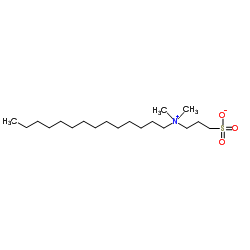3-(N,N-Dimethylmyristylammonio)propanesulfonate

3-(N,N-Dimethylmyristylammonio)propanesulfonate structure
|
Common Name | 3-(N,N-Dimethylmyristylammonio)propanesulfonate | ||
|---|---|---|---|---|
| CAS Number | 14933-09-6 | Molecular Weight | 363.599 | |
| Density | N/A | Boiling Point | N/A | |
| Molecular Formula | C19H41NO3S | Melting Point | 250ºC | |
| MSDS | Chinese USA | Flash Point | >110ºC | |
|
Highly sensitive analysis of flavonoids by zwitterionic microemulsion electrokinetic chromatography coupled with light-emitting diode-induced fluorescence detection.
J. Chromatogr. A. 1358 , 277-84, (2014) A rapid zwitterionic microemulsion electrokinetic chromatography (ZI-MEEKC) approach coupled with light-emitting-diode-induced fluorescence (LED-IF, 480nm) detection was proposed for the analysis of flavonoids. In the optimization process, we systematically i... |
|
|
Metal complexes as artificial proteases in proteomics: a palladium(II) complex cleaves various proteins in solutions containing detergents.
J. Inorg. Biochem. 105(5) , 675-83, (2011) Most popular agents for site-specific protein cleavage are proteolytic enzymes. Because they become denatured and inactivated by detergents, enzymes are inconvenient for proteomic analysis of hydrophobic proteins which require detergents as solubilizing agent... |
|
|
Electrospray mass spectra of three proprietary detergents.
Anal. Biochem. 285(2) , 205-10, (2000) We have determined the major ingredients of the commercially available reagents M-PER, Y-PER, and B-PER from Pierce Chemical Co. using electrospray mass spectrometry. These three proprietary reagents have been widely used in the biochemical community as cell ... |
|
|
Electrokinetic injection across supported liquid membranes: new sample pretreatment technique for online coupling to capillary electrophoresis. Direct analysis of perchlorate in biological samples.
Electrophoresis 33 , 2695, (2012) A simple and sensitive method for quantifying perchlorate in biological samples using CE and capacitively coupled contactless conductivity detection was developed. An online combination of a supported liquid membrane, an inert polypropylene membrane impregnat... |
|
|
Highly selective extraction of spiralin from the Spiroplasma citri cell membrane with alkyl-N-sulfobetaines.
Biochimie 67(12) , 1251-6, (1985) The extraction of proteins from the membrane of the mollicute (mycoplasma) Spiroplasma citri by sodium N-dodecyl-N,N-dimethyl-3-amino-1-propane sulfonate (SB12) and sodium N-tetradecyl-N,N-dimethyl-3-amino-1-propane sulfonate (SB14) was studied with electroph... |
|
|
Structure-efficiency relationships of zwitterionic detergents as protein solubilizers in two-dimensional electrophoresis.
Proteomics 3 , 111-121, (2003) Several zwitterionic detergents differing in their polar heads, linker parts and hydrophobia tail were synthesized and evaluated for their efficiency in protein solubilizers for two-dimensional electrophoresis. A model system consisting of human red blood cel... |
|
|
Comparison of meningococcal outer membrane protein vaccines solubilized with detergent or C polysaccharide.
Antonie van Leeuwenhoek 53(6) , 413-9, (1987) Outer membrane proteins (OMPs) were isolated from meningococcal strain H44/76 (B:15:P1.16) by detergent extraction of bacteria. A final product containing class 1 (P1.16), 3(15), 4 OMPs and 5% (w/w) lipooligosaccharide was obtained. Two experimental vaccines ... |
|
|
Association of annexin A5 with Na+/Ca2+ exchanger and caveolin-3 in non-failing and failing human heart.
J. Mol. Cell. Cardiol. 40(1) , 47-55, (2006) Annexin A5 is a Ca2+ dependent phosphatidylserine binding protein mainly located in the T-tubules and sarcolemma of cardiomyocytes. Our objectives were to determine whether annexin A5 was associated with various protein(s) and whether such an association was ... |
|
|
Effects of detergents on the secondary structures of prion protein peptides as studied by CD spectroscopy.
J. Pept. Sci. 9(4) , 212-20, (2003) Pathogenic prion proteins (PrP(Sc)) are thought to be produced by alpha-helical to beta-sheet conformational changes in the normal cellular prion proteins (PrP(C)) located solely in the caveolar compartments. In order to inquire into the possible conformation... |
|
|
Collagen-binding activity of Prevotella intermedia measured by a microtitre plate adherence assay.
Microbiology 142 ( Pt 6) , 1537-41, (1996) The ability of Prevotella intermedia to bind type I collagen was investigated. A simple method in which bacterial cells were allowed to attach to collagen-coated microtitre plate wells was used to characterize the activity. All strains of P. intermedia tested... |